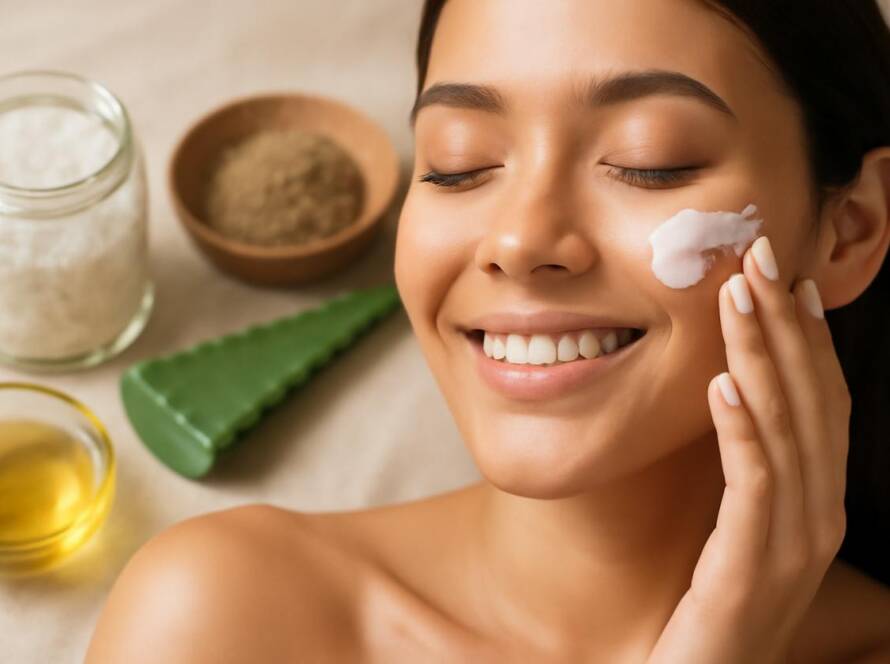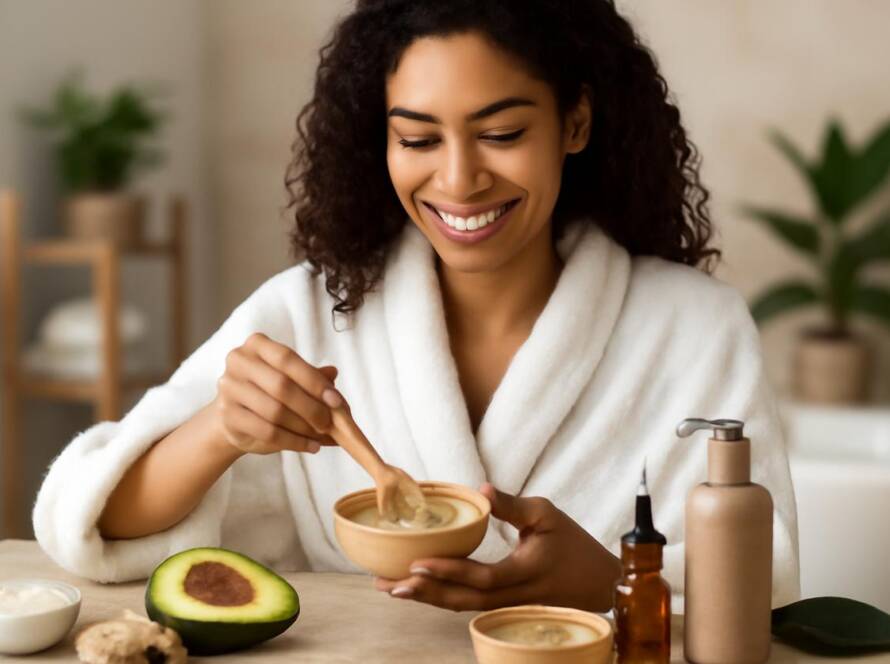Your Ultimate Guide to Achieving Naturally Glowing Skin in 2025 and Beyond
Welcome to your complete guide to unlocking that coveted, lit-from-within glow. The pursuit of glowing skin isn’t about chasing an unrealistic ideal of perfection; it’s about nurturing healthy, vibrant skin that reflects your overall well-being. Forget complicated, 10-step routines and expensive gadgets. This guide focuses on a science-backed, simplified approach that combines gentle daily rituals with powerful nutrition strategies. Whether you’re a complete beginner or just looking to refine your routine, you’ll find clear, actionable steps to reveal your most luminous complexion.
Table of Contents
- Why Skin Loses Its Natural Glow
- How Skin Structure and Hydration Affect Radiance
- Daily Ritual Blueprint for Luminous Skin
- Nutrition for Skin That Reflects Health
- At-Home Treatments and Safe Ingredients to Try
- When to Pause a Routine and Seek Professional Advice
- Common Myths About Glowing Skin Debunked
- Sample Four-Week Plan to Boost Skin Glow
- Quick Troubleshooting Guide for Dull Skin
Why Skin Loses Its Natural Glow
Dull skin is often a sign that something is out of balance. The radiance we associate with glowing skin can be diminished by several factors. Understanding them is the first step toward reclaiming your luminosity.
- Dead Skin Cell Buildup: Your skin is constantly renewing itself, shedding dead cells to make way for new ones. When this process slows down, a layer of dead cells can accumulate on the surface. This rough, uneven layer diffuses light instead of reflecting it, leading to a dull appearance.
- Dehydration: Dehydrated skin lacks water, not oil. When skin cells are parched, they shrivel and flatten, which can make fine lines more prominent and prevent the skin from looking plump and dewy.
- Environmental Stressors: Daily exposure to UV radiation, pollution, and other environmental aggressors creates free radicals. These unstable molecules damage skin cells, break down collagen, and interfere with the skin’s ability to repair itself, ultimately dimming its glow.
- Lifestyle Factors: Chronic stress and lack of sleep can increase cortisol levels in the body. This hormone can trigger inflammation and impair the skin’s barrier function, leading to dryness and dullness.
How Skin Structure and Hydration Affect Radiance
Your skin’s glow is a direct result of its health and structure. Think of your skin’s surface like a smooth, clear lake. When the surface is calm and the water is clear, it reflects light beautifully. The same principle applies to your skin.
The outermost layer, the epidermis, acts as a protective barrier. When it’s well-hydrated and the skin cells are tightly packed and organized, it creates a smooth surface that reflects light evenly. This is the physical characteristic of glowing skin. Below the epidermis lies the dermis, which contains collagen and elastin—proteins that give the skin its firmness and plumpness. Healthy collagen and elastin provide the supportive “scaffolding” that keeps the surface smooth.
Hydration is the critical element that ties it all together. Water plumps up the skin cells in the epidermis, minimizing the appearance of fine lines and creating that dewy, fresh look. A strong, hydrated skin barrier is essential for achieving and maintaining a natural glow.
Daily Ritual Blueprint for Luminous Skin
Consistency is more important than complexity. A simple, repeatable routine using the right ingredients for your skin is the foundation for a healthy glow. We’ve broken it down into a morning and evening ritual that anyone can follow.
Morning Routine: Gentle Prep and Protection
Your morning routine should focus on cleansing away impurities from the night, hydrating, and protecting your skin from the day ahead.
- Step 1: Gentle Cleanse: In the morning, you don’t need a harsh, stripping cleanser. A splash of lukewarm water or a gentle, hydrating cleanser is enough to remove any sweat or oils that have built up overnight without disrupting your skin’s natural moisture barrier.
- Step 2: Antioxidant Serum: This is your shield against environmental damage. A Vitamin C serum is an excellent choice as it helps neutralize free radicals, brightens the complexion, and supports collagen production.
- Step 3: Moisturize: Apply a moisturizer to lock in hydration and support your skin’s barrier. Look for ingredients like hyaluronic acid, ceramides, or glycerin.
- Step 4: Sunscreen (The Non-Negotiable Step): Sunscreen is the single most important product for achieving and maintaining glowing skin. Daily application of a broad-spectrum SPF 30 or higher protects your skin from UV damage, which is a primary cause of dullness, uneven skin tone, and premature aging.
Evening Routine: Repair and Renewal
Your skin does most of its repair work while you sleep. Your evening routine should focus on cleansing the day away and providing ingredients that support this natural renewal process.
- Step 1: Double Cleanse: Start with an oil-based cleanser or micellar water to break down and remove makeup, sunscreen, and surface grime. Follow up with a gentle water-based cleanser to wash everything away and ensure your skin is truly clean.
- Step 2: Gentle Exfoliation (2-3 times per week): Instead of harsh physical scrubs, consider a chemical exfoliant containing Alpha-Hydroxy Acids (AHAs) like glycolic or lactic acid. They work by dissolving the “glue” that holds dead skin cells together, revealing the fresher, brighter skin underneath.
- Step 3: Treatment: This is a great time to use targeted treatments. Serums with ingredients like niacinamide can help with tone and texture, while hyaluronic acid can provide an extra boost of hydration.
- Step 4: Moisturize: Finish with a moisturizer, perhaps one slightly richer than your daytime one, to seal in your treatments and support your skin’s barrier function overnight.
Nutrition for Skin That Reflects Health
Truly glowing skin starts from within. What you eat provides the essential building blocks for healthy skin cells. A balanced diet rich in antioxidants, healthy fats, and vitamins can have a more significant impact on your skin’s radiance than any topical product. For a comprehensive guide on healthy eating, visit the experts at Nutrition and food guidance.
Key Vitamins and Foods to Prioritize
Focus on incorporating a variety of colorful, whole foods into your diet to nourish your skin from the inside out. To learn more about how specific nutrients impact skin, check out this resource on Vitamins for healthy skin.
- Vitamin C (for Brightening): A powerful antioxidant that helps build collagen. Find it in citrus fruits, bell peppers, strawberries, and broccoli.
- Vitamin E (for Protection): Works with Vitamin C to protect skin cells from oxidative damage. Sources include almonds, sunflower seeds, and avocados.
- Omega-3 Fatty Acids (for Hydration): These healthy fats are crucial for a strong skin barrier, helping to keep moisture in and irritants out. Find them in fatty fish like salmon, as well as walnuts and chia seeds.
- Zinc (for Repair): This mineral plays a key role in skin healing and controlling inflammation. Good sources are legumes, seeds, and nuts.
- Water (for Overall Hydration): Don’t underestimate the power of hydration! Drinking enough water throughout the day is fundamental for plump, healthy-looking skin.
At-Home Treatments and Safe Ingredients to Try
You can support your journey to glowing skin with simple, safe, and effective at-home treatments. Always perform a patch test on a small area of skin before applying any new ingredient to your entire face.
- Hydrating Honey Mask: Honey is a natural humectant, meaning it draws moisture into the skin. It also has antibacterial properties. Apply a thin layer of raw honey to clean, damp skin, leave on for 10-15 minutes, and rinse with warm water.
- Soothing Oatmeal Mask: Colloidal oatmeal is fantastic for calming irritated or sensitive skin. Mix finely ground oats with a little water or yogurt to form a paste. Apply, let it sit for 10 minutes, and gently rinse.
- Brightening Yogurt Mask: Plain yogurt contains lactic acid, a gentle AHA that helps exfoliate dead skin cells. Apply a layer of plain, full-fat yogurt, leave it on for 15 minutes, and rinse to reveal softer, brighter skin.
When to Pause a Routine and Seek Professional Advice
Listening to your skin is crucial. If you experience persistent redness, stinging, burning, or peeling, it’s a sign that a product or ingredient isn’t right for you. Stop using the suspected product immediately.
While a consistent routine can significantly improve skin dullness, some conditions require professional help. If you’re struggling with persistent acne, rosacea, severe hyperpigmentation, or other concerns, it’s best to consult a board-certified dermatologist. They can provide an accurate diagnosis and create a personalized treatment plan. For more information, the American Academy of Dermatology offers excellent Professional Skin Care resources.
Common Myths About Glowing Skin Debunked
Navigating skincare advice can be confusing. Let’s clear up some common misconceptions about achieving that healthy glow.
- Myth 1: You need to scrub your skin to make it glow.
Fact: Over-exfoliating with harsh physical scrubs can cause micro-tears in the skin and damage your moisture barrier, leading to irritation and dullness. Gentle chemical exfoliation 2-3 times a week is a much safer and more effective approach for glowing skin.
- Myth 2: Oily skin doesn’t need moisturizer.
Fact: All skin types need hydration. In fact, skipping moisturizer can cause oily skin to become dehydrated, prompting it to produce even more oil to compensate. Opt for a lightweight, non-comedogenic moisturizer to keep your skin balanced and healthy.
- Myth 3: You only see results with expensive products.
Fact: The price tag doesn’t determine a product’s effectiveness. Consistency and the right combination of proven ingredients (like Vitamin C, sunscreen, and gentle exfoliants) are what truly matter. Many affordable drugstore products are incredibly effective.
Sample Four-Week Plan to Boost Skin Glow
Embark on your journey to radiant skin with this simple, progressive plan. The goal is to introduce changes slowly to allow your skin to adapt.
| Week | Focus | Action Steps |
|---|---|---|
| Week 1 | Establish the Foundation |
|
| Week 2 | Introduce Antioxidants |
|
| Week 3 | Incorporate Gentle Exfoliation |
|
| Week 4 | Enhance and Assess |
|
Quick Troubleshooting Guide for Dull Skin
Feeling like your skin has lost its luster? Here are some quick fixes for common issues.
- If your skin feels tight and flaky… your skin is likely dehydrated. Boost your water intake and add a serum with hyaluronic acid before your moisturizer to draw more water into the skin. Consider a slightly richer cream in the evening.
- If your skin looks congested or bumpy… you may have dead skin cell buildup. Ensure you are cleansing thoroughly every night and incorporate gentle exfoliation into your routine as described above.
- If your skin just looks tired… lifestyle factors are often the culprit. Prioritize getting 7-9 hours of quality sleep per night. Incorporate stress-reducing activities like walking or meditation. Your morning antioxidant serum will also help combat a fatigued appearance. For more on how skin ages and repairs, you can explore Skin rejuvenation resources.
Achieving truly glowing skin is a marathon, not a sprint. It’s a holistic practice of consistent care, mindful nutrition, and listening to your body’s needs. By embracing these simple rituals, you are not just working toward a radiant complexion—you are investing in your long-term skin health.



